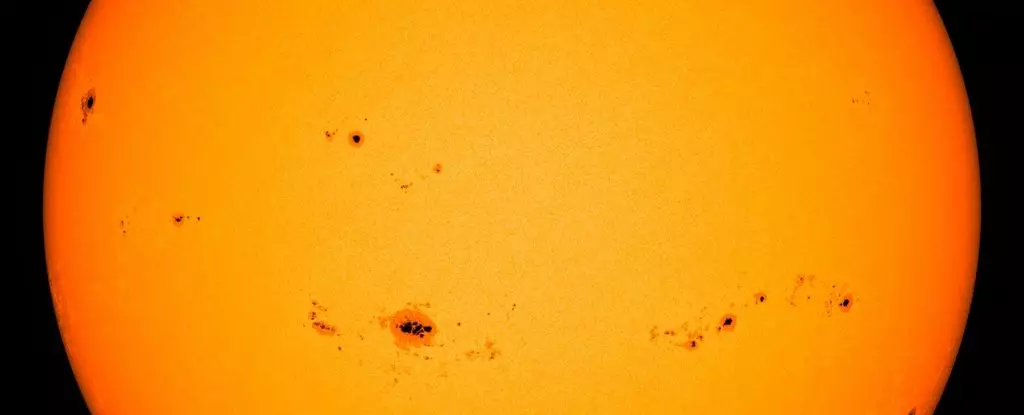The cosmos continually dances to the rhythm of celestial phenomena, and among the most significant components of this cosmic choreography is our Sun. Recently, a joint declaration from NASA, the National Oceanic and Atmospheric Administration (NOAA), and the Solar Cycle Prediction Panel has confirmed the onset of solar maximum. This is a pivotal phase in the Sun’s approximately 11-year cycle of activity, characterized by heightened sunspot frequency, solar flares, and coronal mass ejections (CMEs). The implications of this increased solar activity resonate across space weather dynamics that can potentially impact life on Earth.
While the Sun’s activity is essential for life as we know it, its behavior is anything but predictable. At solar maximum, the Sun begins to exhibit explosive activity, suggesting that the intensity of phenomena such as sunspots and flares will increase significantly in the months to come. However, it is critical to note that we are not fully equipped to pinpoint the exact moment of peak activity within this phase or its subsequent decline. As NOAA meteorologist Elsayed Talaat articulated, “This announcement doesn’t mean that this is the peak of solar activity. The actual month that solar activity peaks won’t be identified for months or years.”
These cycles are defined by the emergence and disappearance of sunspots, regions where the Sun’s magnetic field is particularly strong, disrupting the flow of hot plasma. This disruption results in cooler, darker areas on the solar surface that manifest as sunspots. The cycle progresses through phases of solar minimum—with minimal sunspot activity—to solar maximum, marked by numerous sunspots reminiscent of freckles on a sun-kissed cheek.
The mechanics governing these cycles, however, remain largely elusive. As solar astrophysicist Michael Wheatland notes, our grasp of the solar dynamo—responsible for generating the Sun’s magnetic fields—is incomplete. This knowledge gap stymies our ability to predict these solar cycles accurately, leaving astrophysicists to interpret variations in length and intensity as anomalies rather than definitive trends. Each cycle’s variability accentuates this enigma, posing significant questions for ongoing research.
Navigating the complexities of solar cycles requires careful observation of sunspots, solar flares, and CMEs. Solar flares, which occur when magnetic field lines snap and reconnect, release intense bursts of energy that can disrupt radio signals on Earth. Meanwhile, coronal mass ejections are significant solar events where billions of tons of solar particles are expelled into solar space, presenting potential threats when they collide with Earth’s magnetic field.
Upon interaction with the Earth’s magnetic shield, these emissions can give rise to geomagnetic storms capable of disrupting electrical infrastructures, satellite communications, and navigation systems. Nonetheless, they also offer a stunning visual spectacle: auroras. These ethereal displays are born from solar particles colliding with Earth’s atmosphere, lighting up the skies in a brilliant dance of colors.
This year has been particularly active for auroral events, perhaps signaling a more vigorous solar cycle than initially anticipated. Nonetheless, it is essential to temper excitement with caution—while the current cycle’s intensity has surpassed initial forecasts from NASA and NOAA, it has not reached extremes that would pose a significant threat to our planet.
Amid evolving predictions, analysis of this solar cycle may yield insights that refine our understanding of solar dynamics and enhance predictive models for future solar activity. Some researchers—despite the broader forecasting community projecting milder cycles—had anticipated a more active solar season with remarkable accuracy. This juxtaposition of predictions invokes intriguing considerations regarding the underlying mechanisms of solar cycles and challenges the established modeling techniques.
As scientists adapt their frameworks in light of these revelations, it opens the door to a more nuanced understanding of solar behavior. This adaptability is crucial for bolstering our societal defenses against potential solar storms that can disrupt communications and power systems, while also deepening our appreciation for the complexities of our stellar neighbor.
As we brace ourselves for the impending solar activity, it is vital to monitor the developments closely. Unfolding solar phenomena may not only hold immediate implications for satellite technology and power grids; they can also offer fresh avenues of research into the intricate workings of the Sun.
While we embark on this vibrant phase of solar maximum, the interactions between solar phenomena and Earth remind us of the delicate balance of cosmic forces at play. Though the challenges posed by solar flares and CMEs are real, they provide an invaluable opportunity to deepen our understanding of the Sun’s unpredictable nature and its impact on our lives, propelling us forward in our quest for knowledge about our universe.

